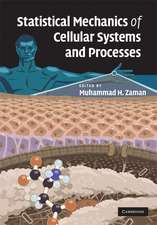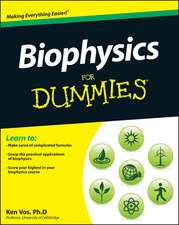Vertebrate Red Blood Cells: Adaptations of Function to Respiratory Requirements: Zoophysiology, cartea 28
Autor Mikko Nikinmaaen Limba Engleză Paperback – 8 dec 2011
Din seria Zoophysiology
- 15%
 Preț: 647.92 lei
Preț: 647.92 lei - 15%
 Preț: 638.76 lei
Preț: 638.76 lei - 15%
 Preț: 638.24 lei
Preț: 638.24 lei - 15%
 Preț: 641.38 lei
Preț: 641.38 lei - 15%
 Preț: 634.82 lei
Preț: 634.82 lei -
 Preț: 386.61 lei
Preț: 386.61 lei - 15%
 Preț: 636.94 lei
Preț: 636.94 lei - 15%
 Preț: 640.88 lei
Preț: 640.88 lei - 15%
 Preț: 635.47 lei
Preț: 635.47 lei - 15%
 Preț: 637.78 lei
Preț: 637.78 lei - 15%
 Preț: 640.88 lei
Preț: 640.88 lei -
 Preț: 386.61 lei
Preț: 386.61 lei - 15%
 Preț: 637.78 lei
Preț: 637.78 lei - 15%
 Preț: 638.24 lei
Preț: 638.24 lei - 15%
 Preț: 642.83 lei
Preț: 642.83 lei - 15%
 Preț: 634.68 lei
Preț: 634.68 lei - 15%
 Preț: 642.83 lei
Preț: 642.83 lei - 18%
 Preț: 999.60 lei
Preț: 999.60 lei - 15%
 Preț: 638.43 lei
Preț: 638.43 lei - 15%
 Preț: 651.34 lei
Preț: 651.34 lei - 15%
 Preț: 638.57 lei
Preț: 638.57 lei - 15%
 Preț: 637.46 lei
Preț: 637.46 lei - 15%
 Preț: 637.59 lei
Preț: 637.59 lei - 15%
 Preț: 641.53 lei
Preț: 641.53 lei - 15%
 Preț: 636.80 lei
Preț: 636.80 lei -
 Preț: 386.22 lei
Preț: 386.22 lei - 15%
 Preț: 632.55 lei
Preț: 632.55 lei - 15%
 Preț: 695.19 lei
Preț: 695.19 lei -
 Preț: 401.24 lei
Preț: 401.24 lei - 18%
 Preț: 942.01 lei
Preț: 942.01 lei - 18%
 Preț: 945.30 lei
Preț: 945.30 lei - 15%
 Preț: 652.17 lei
Preț: 652.17 lei - 15%
 Preț: 632.70 lei
Preț: 632.70 lei - 15%
 Preț: 640.71 lei
Preț: 640.71 lei - 15%
 Preț: 644.30 lei
Preț: 644.30 lei - 15%
 Preț: 642.68 lei
Preț: 642.68 lei
Preț: 639.41 lei
Preț vechi: 752.24 lei
-15% Nou
Puncte Express: 959
Preț estimativ în valută:
122.35€ • 127.74$ • 101.26£
122.35€ • 127.74$ • 101.26£
Carte tipărită la comandă
Livrare economică 04-18 aprilie
Preluare comenzi: 021 569.72.76
Specificații
ISBN-13: 9783642839115
ISBN-10: 3642839118
Pagini: 276
Ilustrații: XII, 262 p.
Dimensiuni: 155 x 235 x 14 mm
Greutate: 0.39 kg
Ediția:Softcover reprint of the original 1st ed. 1990
Editura: Springer Berlin, Heidelberg
Colecția Springer
Seria Zoophysiology
Locul publicării:Berlin, Heidelberg, Germany
ISBN-10: 3642839118
Pagini: 276
Ilustrații: XII, 262 p.
Dimensiuni: 155 x 235 x 14 mm
Greutate: 0.39 kg
Ediția:Softcover reprint of the original 1st ed. 1990
Editura: Springer Berlin, Heidelberg
Colecția Springer
Seria Zoophysiology
Locul publicării:Berlin, Heidelberg, Germany
Public țintă
ResearchCuprins
1. Introduction.- 2. Erythropoiesis and the Control of Circulating Red Cell Number.- 2.1 Erythropoietic Sites.- 2.2 Mammalian Erythropoiesis.- 2.3 Erythropoiesis in Nonmammalian Vertebrates.- 2.4 Senescence of Red Blood Cells.- 2.5 Erythropoiesis-Independent Factors Increasing Circulating Red Cell Number.- 3. The Biosynthesis and Structure of Haemoglobin.- 3.1 Uptake of Iron into Erythroid Cells.- 3.2 Haem Synthesis.- 3.3 Globin Synthesis.- 3.4 Subunit Assembly of Haemoglobin.- 3.5 Haemoglobin Structure in Vertebrates.- 4. Structure of Circulating Red Cells.- 4.1 General Anatomy of the Cell.- 4.2 The Red Cell Membrane.- 5. Red Cells in Circulation: Factors Affecting Red Cell Shape and Deformability.- 5.1 Blood Viscosity.- 5.2 Deformability of Red Cells.- 6. Energy Metabolism and Regulation of Organic Phosphate Concentrations.- 6.1 Energy Consumption.- 6.2 Transport of Substrates into the Red Cells.- 6.3 Glycolysis.- 6.4 Pentose Phosphate Pathway and Glutathione Metabolism.- 6.5 Krebs Cycle and Oxidative Phosphorylation.- 6.6 Organic Phosphate Metabolism.- 6.7 Cellular Control of Red Cell Organic Phosphate Concentrations.- 7. Major Ion Transporting Pathways.- 7.1 Electrodiffusive Leak.- 7.2 Ion Channels.- 7.3 Anion Exchange.- 7.4 Ion Transport Coupled to Sodium or Potassium Gradient.- 7.5 Active Transport.- 7.6 Membrane Potential.- 8. Control of Volume and pH.- 8.1 The Basic Model: Control of Red Cell pH and Volume in the Absence of Significant Secondarily Active Transport.- 8.2 Mammalian Red Cells.- 8.3 Avian Red Cells.- 8.4 Reptilian Red Cells.- 8.5 Amphibian Red Cells.- 8.6 Fish Red Cells.- 9. Carbon Dioxide Transport.- 9.1 Distribution of Total Carbon Dioxide Content Between Red Cells and Plasma.- 9.2 Carbon Dioxide — Bicarbonate Equilibria.- 9.3 Formation ofCarbamino Compounds.- 9.4 Mechanisms of Carbon Dioxide Excretion.- 10. Oxygen Transport.- 10.1 Haemoglobin-Oxygen Equilibria — Basic Principles.- 10.2 Methods for Determining Blood/Haemoglobin Oxygen Content and Oxygen Equilibrium Curves.- 10.3 Molecular Aspects of Haemoglobin-Oxygen Binding.- 10.4 Formation and Reduction of Methaemoglobin.- 10.5 Cellular and Molecular Adaptations of Haemoglobin Function to Variations in Respiratory Requirements.- References.













